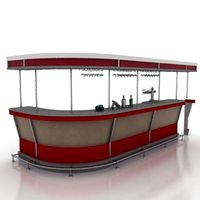Thingiverse

Roebel bar conductor by Xylitol
by Thingiverse
Last crawled date: 3 years ago
EN - English:A roebel bar is composed of insulated copper conductors (strands) transposed by the Roebel methods, it is know for improving the efficiency and performance of large electrical machines. It was invented in 1912 by Ludwig Roebel and till today roebel transposition is widely used/adopted for high voltage applications, e.g: power plants stators.
This small half-bar is composed of 5 strands that you need to assemble.
The bar modelisation is based on the wikipedia image uploaded by Christian Barth.You will need a 180mm printable area.
i used Solidworks 2015 and the rendering is done by KeyShot.
Printed in 0.1mm, ABS, smoothed with acetone.FR - Français:Invention de Ludwig Roebel (BBC Mannheim) avec brevet en 1912.
La transposition roebel consiste à échanger au sein de la barre, la position des brins de cuivre par pliage avec changement de niveau et de coté.
Cette technique a pour but d'équilibrer le flux sur l'ensemble des conducteurs de la barre afin d'éviter les échauffements par apparition de courants parasites (courants de boucle)
La plupart des centrale électriques dans le monde utilise cette technologie.
La modélisation du conducteur est basé sur l'image de Christian Barth trouvable sur wikipedia.
Vous aurez besoin d'une zone d'impression minimum de 180mm.
This small half-bar is composed of 5 strands that you need to assemble.
The bar modelisation is based on the wikipedia image uploaded by Christian Barth.You will need a 180mm printable area.
i used Solidworks 2015 and the rendering is done by KeyShot.
Printed in 0.1mm, ABS, smoothed with acetone.FR - Français:Invention de Ludwig Roebel (BBC Mannheim) avec brevet en 1912.
La transposition roebel consiste à échanger au sein de la barre, la position des brins de cuivre par pliage avec changement de niveau et de coté.
Cette technique a pour but d'équilibrer le flux sur l'ensemble des conducteurs de la barre afin d'éviter les échauffements par apparition de courants parasites (courants de boucle)
La plupart des centrale électriques dans le monde utilise cette technologie.
La modélisation du conducteur est basé sur l'image de Christian Barth trouvable sur wikipedia.
Vous aurez besoin d'une zone d'impression minimum de 180mm.
Similar models
3dwarehouse
free

VILLA GIULIETTA
...calage. elle se compose d'un toit terasse très agréable avec son jacuzzi. la construction est posé en partie sur pilotis.
3dwarehouse
free

AMES VISUAL ILLUSIONS
...outil des composants dynamiques, puis sur la fenêtre pour lancer l'animation. #ames #dc #dynamic_components #visual_illusions
3dwarehouse
free

VILLA GIULIETTA
...ge. elle se compose d'un toit terasse très agréable avec son jacuzzi. la construction est posé en partie sur pilotis.
thingiverse
free

DE200 FIX TOP avec LED intégrées by ragnaroque
...et la masse.
atention: après cela les barres seront sous tension, ne faite pas de cour jus avec un objet conducteur !
bon print!!
thingiverse
free

Bouton Pression by crocot
...es trous puis coudre le bouton sur un vêtement.
cette objet fait partie d'un projet plus grand a cours avec la carte myoware.
3dwarehouse
free

COMPOUND GEAR TRAINS DYNAMIC COMPONENTS
...posants dynamiques, puis sur un des engrenages pour lancer l'animation. #gears #dc #dynamic_components #composants_dynamiques
grabcad
free

Garde-corps paramétré avec tronçons (Parametric railing) - TopSolid 7
...négalité des tronçons et dans la constance des poteaux, l'entraxes est calculé sur la globalité et non par sur chaque tronçon
thingiverse
free

Tuyère soufflage 40mm pour ventilateur by Nicolas65
...dissipateur de la tête et l'envois à coté limitant ainsi le courant d'air, utile lors de l'impression d'abs :-)
3dwarehouse
free

porte placard coulissantes
...erture et la fermeture sont réglables par les options du composant. #aménagement #composant #coulissant #dynamique #porte_placard
3dwarehouse
free

ORIGAMI, Armoire en bois L 105 cm, Maisons du monde, ref : 155636, prix : 799,90
...ric_tabary #armario #armoire #bedroom #bois #brown #chambre #dormitorio #madera #maisons_du_monde #marron #marrón #wardrobe #wood
Xylitol
thingiverse
free

Temari bookmark by Xylitol
...temari bookmark by xylitol
thingiverse
temari bookmark for all of you temari fans (:
thingiverse
free

Clé Decaux by Xylitol
...clé decaux by xylitol
thingiverse
key to open jcdecaux bus shelter panels and others outdoor advertising panels.
thingiverse
free

Coil former by Xylitol
...coil former by xylitol
thingiverse
https://hackaday.io/project/12405-stark-155
printed in 0.1mm with abs, smoothed with acetone.
thingiverse
free

Temari coin by Xylitol
... coin by xylitol
thingiverse
collector coin of temari (naruto) original from j-world tokyo, did a 600 dpi scan and 3d redrawn it
thingiverse
free

EMP Generator by Xylitol
...s an emp generator project, pcb design and explanation can be found on this page: https://hackaday.io/project/10464-emp-generator
thingiverse
free

Clef de Berne by Xylitol
...clef de berne by xylitol
thingiverse
berne key of 1938 used by railworkers.https://fr.wikipedia.org/wiki/cl%c3%a9_de_berne
thingiverse
free

Apple Extended Keyboard II Keycap by Xylitol
...apple extended keyboard ii keycap by xylitol
thingiverse
keycap for apple extended keyboard ii
thingiverse
free

Button by Xylitol
...;push' the button, i was bored of this sh*t so i designed a replacement.
printed in 0.1mm with abs and smoothed with acetone.
thingiverse
free

Conveyor roll by Xylitol
...thed with acetone and fit m6 rods.
printable in a 200mm area, in case you can't, print roller short in 2pcs to make one long.
thingiverse
free

Mooltipass Mini Stand by Xylitol
...our desktop.
printed with abs, 0.1mm, acetone smoothed
--edit:
added a modified version who should be easier to print vertically.
Conductor
3d_export
$15

conductor
...conductor
3dexport
version 3ds max 2014 and higher. the format is obj, stl, fbx. model for printing on a 3d printer.
turbosquid
$65

LSHF Single Core with Copper Conductor
... available on turbo squid, the world's leading provider of digital 3d models for visualization, films, television, and games.
turbosquid
$65

LSHF Multi Core with Copper Conductor Unarmored Cable
... available on turbo squid, the world's leading provider of digital 3d models for visualization, films, television, and games.
turbosquid
$65

LSHF Insulated Multi Core with Copper Conductor Cable
... available on turbo squid, the world's leading provider of digital 3d models for visualization, films, television, and games.
turbosquid
$65

LSHF Insulated Single Core with Copper Conductor Cable
... available on turbo squid, the world's leading provider of digital 3d models for visualization, films, television, and games.
turbosquid
$65

LSHF Insulated Single Core with Aluminum Conductor Unarmored Cable
... available on turbo squid, the world's leading provider of digital 3d models for visualization, films, television, and games.
turbosquid
$65

LSHF Insulated Multi Core with with Copper Conductor Wire Armored Cable
... available on turbo squid, the world's leading provider of digital 3d models for visualization, films, television, and games.
turbosquid
$65

LSHF Insulated Multi Core with with Copper Conductor Wire Armored Cable
... available on turbo squid, the world's leading provider of digital 3d models for visualization, films, television, and games.
turbosquid
$65

LSHF Insulated Multi Core with with Copper Conductor Steel Tape Armored Cable
... available on turbo squid, the world's leading provider of digital 3d models for visualization, films, television, and games.
3d_export
$35

Music Stand 3D Model
...music stand 3d model 3dexport stand conductor props music object music stand 3d model archicube.3d 74250...
Bar
archibase_planet
free

Bar
...bar
archibase planet
bar bar rack
bar 2 - 3d model for interior 3d visualization.
archibase_planet
free

Bars
...bars
archibase planet
horizontal bar parallel bars
parallel bars - 3d model for interior 3d visualization.
3d_export
$10

bar
...bar
3dexport
modern bar
3d_export
$10

bar
...bar
3dexport
modern bar
3d_export
$10

bar
...bar
3dexport
modern bar
3d_export
$10

bar
...bar
3dexport
modern bar
3d_export
$10

bar
...bar
3dexport
modern bar
3d_export
$10

bar
...bar
3dexport
modern bar
3d_export
$10

bar
...bar
3dexport
modern bar
3d_export
$10

bar
...bar
3dexport
modern bar

